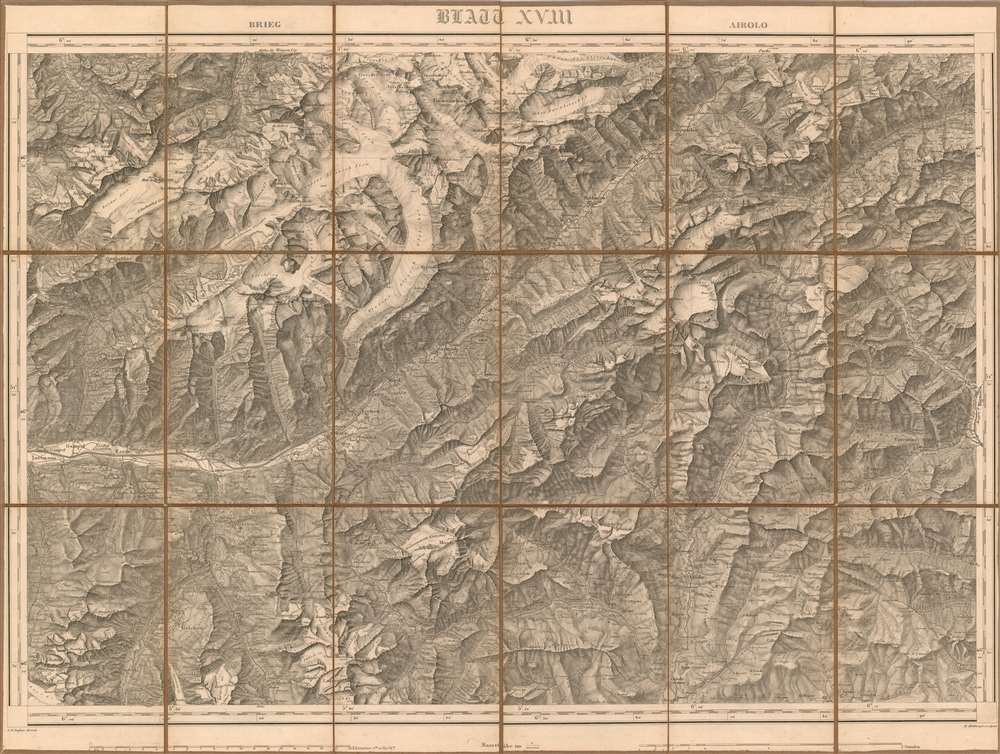1875 Dufour Map of the cantons of Vaud and Valais from the First Accurate National Survey
VeveySion-dufour-1875
Title
1875 (dated) 21.5 x 29 in (54.61 x 73.66 cm) 1 : 100000
Description
The Dufour Map
This Brig-Airolo map is sheet 18 of Guillaume Henri Dufour’s monumental, twenty-five sheet topographical map of Switzerland. The Dufour map was the first geometrically accurate depiction of the recently formed Swiss confederation . Work was initiated on the 1:100000 topographic map of Switzerland in 1832; the twenty-five sheets - each covering an area of 70 by 48 kilometers - were published serially between 1845 and 1865.An Organizational Feat
Dufour oversaw the work of numerous scientists, topographers and engravers in order to achieve this masterpiece. Between 1834 and 1837 geodesist Johannes Eschmann compiled existing cantonal networks to form a ‘Triangulation primordiale,’ the first modern nationwide triangulation spanning Switzerland from the north to the south; these provided the geodetic reference system which formed the framework for the Dufour Map. Simultaneously, Dufour enlisted a team of surveyors to supply topographic data. In order to organize the efforts of so many - from survey to engraving - Dufour founded the Federal Topographical Bureau in Geneva in 1838.An Astonishing Degree of Precision
The surveys were executed at a very high resolution, ranging from 1:50000 in alpine areas to 1:25000 in the Central Plateau, Jura and Southern Ticino areas; these were integrated into Eschmann’s framework before surveys could even begin. While Dufour specified that his surveyors should do so ‘as accurately as possible’ it should be noted that there existed at the time no quantifiable standard for such accuracy to which to refer. In spite of this, analysis of the Dufour maps reveal a mean deviation of only 153 metres - a mere 1.5 millimeters on the map!A Pinnacle of the Engravers’ Art
After the original surveys were examined, they were then reached to the scale of 1:100,000 for uniformity, then transferred to copperplate, engraved, and printed. The Dufour maps are justifiably held in regard for the quality of their engraving, particularly in the presentation of Switzerland’s wildly varied terrain. The maps’ beautiful shading resulted in their distinctive three-dimensional effect. During a period in which the mapmaker’s art was increasingly moving to lithography, the execution of these maps in copperplate represents a triumph of the cartographic medium dominant from the 16th century on. The map’s quality was hailed from its production: the 1875 journal XXXX, reporting the cartographic offerings of that year’s Geographical Congress at Paris, set it above the pack:Switzerland, though one of the smallest countries in Europe, nevertheless holds a foremost rank in this exhibition. The large Federal map, produced under the direction of General Dufour, - of whose recent decease we are reminded by the crepe ceiling the Swiss coat-of-arms, - is certainly one of the finest specimens of cartography in a large scale to be seen here. A comparison of it with the Swiss atlas surveyed 1786-1802 by Weiss, a copy of which is exhibited, forcibly brings home to us the great strides which the art of cartography has made since then.
Publication History and Census
The first sheets of the Dufour map were published in 1845 with the project culminating in 1865; it can be presumed that the individual maps were published in multiple editions in the intervening period. Nevertheless, we see only six examples of this separate sheet in institutional collections, and we do not see it on the market. The complete set is reasonably well represented in institutional collections.Cartographer
Guillaume Henri Dufour (September 15, 1787 - July 14, 1875) was a Swiss army officer, engineer and topographer. Though a career General and victorious military leader, he in 1864 presided over the First Geneva Convention, establishing the International Red Cross. As pertains to the cartographic world, was founder and president (1838 to 1865) of the Swiss Federal Office of Topography. The son of a watchmaker, Dufour had been sent school in Geneva where he studied medicine and drawing. He would go on to the École Polytechnique in Paris, then a military academy, where he studied descriptive geometry; this he followed studying military engineering at the École d'Application. When in 1810 he was sent to help defend Corfu against the British, he spent his downtime mapping the island's old fortifications. Later in his career he would be awarded the Croix de la Légion d'Honneur for his work repairing fortifications at Lyons. He returned to Switzerland in 1817, and to become commander of the Canton of Geneva's military engineers, as well becoming professor of mathematics at the University of Geneva. He continued to rise through the ranks and in 1831 was appointed quartermaster-general. In that capacity he was in 1833 commissioned to execute a trigonometrical survey of Switzerland. The final result of this monumental work, printed to 25 sheets on the scale of 1⁄100000, was published between 1842 and 1865. The Dufourspitze (the highest mountain peak in Switzerland) is named in honor of Dufour's cartographic achievements. More by this mapmaker...

